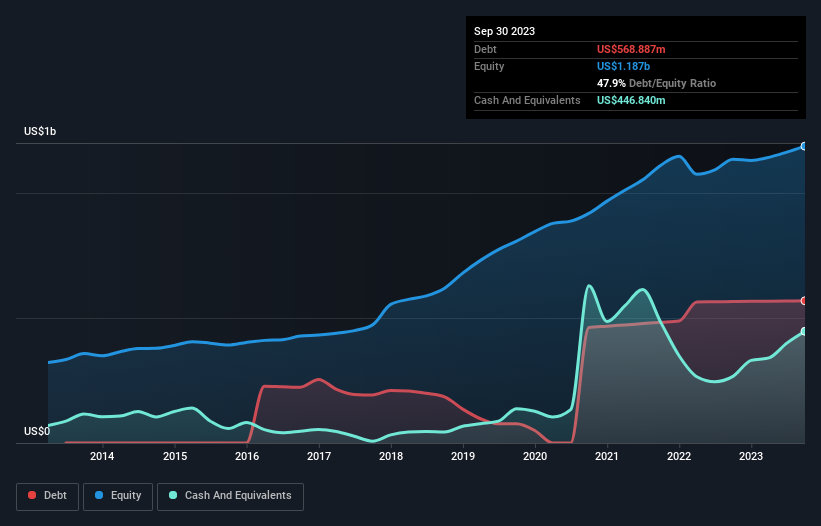- United States
- /
- Medical Equipment
- /
- NasdaqGS:OMCL
Does Omnicell (NASDAQ:OMCL) Have A Healthy Balance Sheet?
Some say volatility, rather than debt, is the best way to think about risk as an investor, but Warren Buffett famously said that 'Volatility is far from synonymous with risk.' So it might be obvious that you need to consider debt, when you think about how risky any given stock is, because too much debt can sink a company. We note that Omnicell, Inc. (NASDAQ:OMCL) does have debt on its balance sheet. But the real question is whether this debt is making the company risky.
Why Does Debt Bring Risk?
Generally speaking, debt only becomes a real problem when a company can't easily pay it off, either by raising capital or with its own cash flow. If things get really bad, the lenders can take control of the business. However, a more common (but still painful) scenario is that it has to raise new equity capital at a low price, thus permanently diluting shareholders. Of course, plenty of companies use debt to fund growth, without any negative consequences. The first thing to do when considering how much debt a business uses is to look at its cash and debt together.
Check out our latest analysis for Omnicell
How Much Debt Does Omnicell Carry?
The chart below, which you can click on for greater detail, shows that Omnicell had US$568.9m in debt in September 2023; about the same as the year before. However, it does have US$446.8m in cash offsetting this, leading to net debt of about US$122.0m.

How Strong Is Omnicell's Balance Sheet?
The latest balance sheet data shows that Omnicell had liabilities of US$369.4m due within a year, and liabilities of US$664.8m falling due after that. Offsetting these obligations, it had cash of US$446.8m as well as receivables valued at US$284.2m due within 12 months. So its liabilities outweigh the sum of its cash and (near-term) receivables by US$303.1m.
Of course, Omnicell has a market capitalization of US$1.55b, so these liabilities are probably manageable. However, we do think it is worth keeping an eye on its balance sheet strength, as it may change over time. When analysing debt levels, the balance sheet is the obvious place to start. But ultimately the future profitability of the business will decide if Omnicell can strengthen its balance sheet over time. So if you're focused on the future you can check out this free report showing analyst profit forecasts.
Over 12 months, Omnicell made a loss at the EBIT level, and saw its revenue drop to US$1.2b, which is a fall of 9.4%. That's not what we would hope to see.
Caveat Emptor
Importantly, Omnicell had an earnings before interest and tax (EBIT) loss over the last year. To be specific the EBIT loss came in at US$40m. Considering that alongside the liabilities mentioned above does not give us much confidence that company should be using so much debt. Quite frankly we think the balance sheet is far from match-fit, although it could be improved with time. For example, we would not want to see a repeat of last year's loss of US$34m. So in short it's a really risky stock. For riskier companies like Omnicell I always like to keep an eye on whether insiders are buying or selling. So click here if you want to find out for yourself.
When all is said and done, sometimes its easier to focus on companies that don't even need debt. Readers can access a list of growth stocks with zero net debt 100% free, right now.
New: AI Stock Screener & Alerts
Our new AI Stock Screener scans the market every day to uncover opportunities.
• Dividend Powerhouses (3%+ Yield)
• Undervalued Small Caps with Insider Buying
• High growth Tech and AI Companies
Or build your own from over 50 metrics.
Have feedback on this article? Concerned about the content? Get in touch with us directly. Alternatively, email editorial-team (at) simplywallst.com.
This article by Simply Wall St is general in nature. We provide commentary based on historical data and analyst forecasts only using an unbiased methodology and our articles are not intended to be financial advice. It does not constitute a recommendation to buy or sell any stock, and does not take account of your objectives, or your financial situation. We aim to bring you long-term focused analysis driven by fundamental data. Note that our analysis may not factor in the latest price-sensitive company announcements or qualitative material. Simply Wall St has no position in any stocks mentioned.
About NasdaqGS:OMCL
Omnicell
Provides medication management solutions and adherence tools for healthcare systems and pharmacies the United States and internationally.
Excellent balance sheet and slightly overvalued.
Similar Companies
Market Insights
Community Narratives



